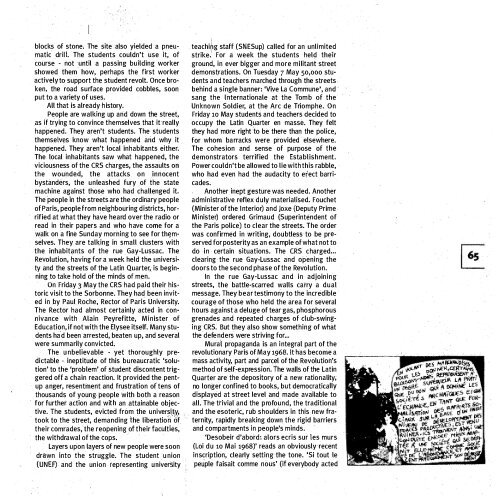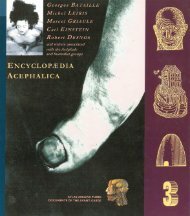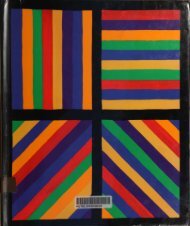SITUATIONISTS AND THE 1£CH MAY 1968
umMYFs
umMYFs
You also want an ePaper? Increase the reach of your titles
YUMPU automatically turns print PDFs into web optimized ePapers that Google loves.
locks of stone. The site also yielded a pneumatic<br />
drill. The students couldn't use it, of<br />
course • not until a passing building worker<br />
showed them how, perhaps the first worker<br />
actively to support the student revolt. Once broken,<br />
the road surface provided cobbles, soon<br />
put to a variety of uses.<br />
All that is already history.<br />
People are walking up and down the street,<br />
.as if trying to convince themselves that it really<br />
happened. They aren't students. The students<br />
themseiV('!S know what happened arid why it<br />
happened. They aren't local inhabitants either.<br />
The local inhabitants saw what happened, the<br />
viciousness of the CRS charges, the assaults on<br />
the wounded, the attacks on innocent<br />
bystanders, the unleashed fury of the state<br />
machine against those who had challenged it.<br />
The people in the streets are the ordinary people<br />
of Paris, people from neighbouring districts, horrified<br />
at what they have heard over the radio or<br />
read in their papers and who have come for a<br />
walk on a fine Sunday morning to see for thmselves.<br />
They are talking in small clusters with<br />
the inhabitants of the rue Gay-Lussac. The<br />
Revolution, having for a week held the universi·<br />
ty and the streets of the Latin Quarter, is beginning<br />
to take hold of the minds of men.<br />
On Friday 3 May the CRS had paid their his·<br />
toric visit to the Sorbonne. They had been invit·<br />
ed in by Paul Roche, Rector of Paris University.<br />
The Rector had almost certainly acted in con·<br />
nivance with Alain Peyrefitte, Minister of<br />
Education, if not with the Elysee itself. Many stu·<br />
dents had been arrested, beaten up, and several<br />
were summarily convicted.<br />
The unbelievable • yet thoroughly predictable<br />
ineptitude of this bureaucratic 'solu·<br />
tion' to the 'problem' of student discontent triggered<br />
off a chain reaction. lt provided the pent·<br />
up anger, resentment and frustration of tens of<br />
thousands of young people with both a reason<br />
for further action and with an attainable objective.<br />
The students, evicted from the university,<br />
took to the street, demanding the liberation of<br />
their comrades, the reopening of their faculties,<br />
·<br />
the withdrawal ofthe cops.<br />
Layers upon layers of new people were soon<br />
drawn into the struggle. The student union<br />
(UNEF) and the union representing university<br />
teachihg staff (SNESup) called for an unlimited<br />
strike. ' For a week the students held their<br />
ground, in ever bigger and more militant street<br />
demonstrations. On Tuesday 7 May so,ooo stu·<br />
dents and teachers march('!d through the streets<br />
behind a single banner: 'Vive La Commune', and<br />
sang the lnternationale at the Tomb of the<br />
Unknown Soldier, at the Arc de Triomphe. On<br />
Friday 10 May students and teachers decided to<br />
occupy the Latin Quarter en masse. They felt<br />
they had more right to be there than the police,<br />
for whom barracks were provided elsewhere.<br />
The cohesion and sense of purpose of the<br />
demonstrators terrified the Establishment.<br />
Power couldn't be allowed to lie with this rabble,<br />
who had even had the audacity to erect barricades.<br />
Another inept gesture was needed. Another<br />
administrative reflex duly materialised. Fouchet<br />
(Minister of the Interior) and joxe (Deputy Prime<br />
Minister) ordered Grimaud (Superintendent of<br />
the Paris police) to clear the streets. The order<br />
was confirmed in Writing, doubtless to be preserved<br />
for posterity as an example of what not to<br />
do in · certain situations. The CRS charged ...<br />
clearing the rue Gay-Lussac and opening the<br />
doors to the second phase of the Revolution.<br />
In the rue Gay-Lussac and in adjoining<br />
streets, the battle-scarred walls carry a dual<br />
message. They bear testimony to the incredible<br />
courage of those who held the area for several<br />
hours against a deluge of tear gas, phosphorous<br />
grenades and repeated charges of dub-swinging<br />
CRS. But they also show something of what<br />
the defenders were striving for ...<br />
Mural propaganda is an integral part of the<br />
revolutionary Paris of May <strong>1968</strong>. it has become a<br />
mass activity, part and parcel of the Revolution's<br />
method of self-expression. the walls of the Latin<br />
Quarter are the depository of a new rationality;<br />
no longer confined to books, but democratically<br />
displayed at street level and made available to<br />
all. The trivial and the profound, the traditional<br />
and the esoteric, rub shoulders in this new fraternity,<br />
rapidly breaking down the rigid barriers<br />
and compartments in people's minds.<br />
'Desobeir d'abord: alors ecris sur \es murs<br />
(Loi du 10 Mai <strong>1968</strong>)' reads an obviously recent<br />
inscription, clearly setting the tone. 'Si tout le<br />
peuple faisait comme no us' (if everybody acted










